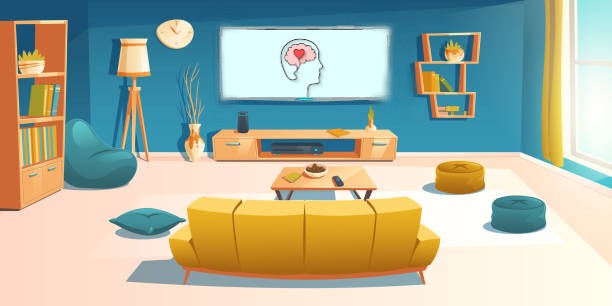Mental Health on Screen
From TV to film, mental health disorders surrounding teens can be depicted in a way that brings serious issues to light without romanticizing them.
Everyday, mental health is portrayed on our TV screens.
March 9, 2023
49.5% of adolescents will be diagnosed with mental health disorders in their lifetime. Of the world’s population suffering from mental illnesses, approximately two-thirds of them will go unnoticed.
For many, a mental health diagnosis is hard to accept. Additionally, the pressures of society and social media only make it harder. Most do not even know the signs of struggling with mental health until it is too late.
Currently, with a wave of oversimplified mental health topics in film and on TV, people have formed a diluted conception of what mental health actually looks like. These displays are inaccurate and triggering and are leading to inaccurate diagnoses. For teens, these displays make it even harder to comprehend their emotions.
“Film dominates the environment of the viewer, who interacts with the film psychophysically,” explains film researcher Mark O’Hara.
When these incorrect displays constantly plague TV screens and streaming services, it creates a blurred line between reality and fiction.
However, some popular adult shows, like Shameless, depict the harsh realities of addiction and bipolar disorder without glamorization. In addition, the Oscar-winning movie Silver Linings Playbook shows the true adult struggles of living with bipolar disorder.
Recently, teen dramas have taken on concepts of mental health.
The Netflix original Ginny and Georgia portrays self-harm. The show is centered around the mother-daughter relationship of Ginny (Antonia Gentry) and Georgia (Brianne Howey), as they adjust to a wealthy picturesque town. While the mom, Georgia, struggles to be a perfect maternal figure, Ginny faces racism and friendship struggles at her new school. As Ginny grapples with her difficult past, her father’s absence, and one-sided relationships, she begins to harm herself.
The second season, released in 2023, dives further into self-harm and depression, plus how it affects the people around them. The topics are not glossed over and show how unnoticed these struggles can become. Georgia’s reaction to discovering her daughter’s self-harm is pure and seemingly somewhat accurate.
While the show is funny and dramatic, it is also a current and accurate depiction of the struggles of mental health for everyone, especially teens, since feelings of anxiety and hopelessness exacerbate by 71% between the ages of 17 and 25.
It is the duty of the film industry to ensure mental health is portrayed responsibly and accurately to ensure people can get the help they need and deserve.
Even though these modern adaptations offer a fresh and accurate perspective, mental health has been portrayed in the arts for centuries. In Shakespeare’s Macbeth, Lady Macbeth commits suicide, but her struggles are ignored and she never receives a diagnosis. While this is a time when mental health was not documented, it shows a stereotype of mental health. These stereotypes continue to plague parts of the media today, with the horror exaggeration of Split, which illustrates a dangerous image of Dissociative Identity Disorder.
At the same time, these stereotypes have fostered movies for kids that showcase emotions in a way that is easy to understand. The 2015 family comedy Inside Out gave a one-sided yet necessary interpretation of mental health in children. The movie uses each emotion to hint at mental illness diagnoses, like depression, anxiety, and obsessive compulsive disorder (OCD). Because of this movie, kids were able to better comprehend human, everyday struggles before they entered their teenage years.

In addition, the iconic teen movie The Perks of Being a Wallflower showcases the tribulations of depression as a teenager, Charlie, struggles through high school.
The movie begins as socially distant Charlie starts high school. While viewers don’t get a full backstory of Charlie’s life, they see enough to piece together that he suffers from depression. His absence of memories shows the blackouts and hazy times many people with depression have. As in most coming of age movies, we see Charlie immerse himself in a new friend group and further his love for writing, helped by his favorite english teacher.
However, this is no average teen movie. While it feels as though everything in Charlie’s life may be headed in a brighter direction, the movie finishes with Charlie having a mental break and being institutionalized. Unlike other films. Perks offers a glimpse of what it is like to be institutionalized, and like Ginny and Georgia, the strain it puts on a family.
Although the movie is hard to watch, it is a breakthrough for the stigma that is mental health. It offers a fresh message that teens need to process their feelings as they enter a new stage in life.
When teen media opens itself to mental health topics, it is a societal responsibility to ensure it is not triggering. Even with progress in how mental health is presented, many popular shows still use a serious issue as a mere plot line.
Psychiatrist Goali Saedi Bocci, commented on the show, saying, “I’d argue that in fact the severely mentally ill are actually just trying to hold onto hope and deal with life one day at a time. The energy expenditure required for a severely depressed patient to exercise let alone plan some scheme is essentially nonexistent.”
Even though viewers who struggle with mental health disorders are increasingly fortunate to see more of themselves on screen, the way those disorders have been portrayed has been seriously damaging. The media must be held responsible for playing a part in the problem.












